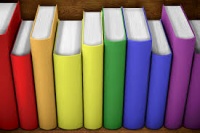Difference between revisions of "LGBTQ Romance Writers"
| (2 intermediate revisions by the same user not shown) | |||
| Line 66: | Line 66: | ||
* [[Jeannie Levig]] | * [[Jeannie Levig]] | ||
* [[James Lovejoy]] | * [[James Lovejoy]] | ||
| + | * [[Casey McQuiston]] | ||
* [[Susan X Meagher]] | * [[Susan X Meagher]] | ||
* [[Gordon Merrick]] | * [[Gordon Merrick]] | ||
| Line 86: | Line 87: | ||
* [[Prominent Biographers Who are LGBTQ]] | * [[Prominent Biographers Who are LGBTQ]] | ||
* [[LGBTQ Travel Writers]] | * [[LGBTQ Travel Writers]] | ||
| + | * [[Translators Who Identify as LGBTQ]] | ||
| + | * [[Short Story Writers from the LGBTQ Community]] | ||
==Further Reading/Research== | ==Further Reading/Research== | ||
Latest revision as of 20:04, 26 November 2023
To many in the LGBTQ community, romance novels have been an inspirational outlet for our same-sex attractions and desires. They allow the reader to wander off into a world of desire and emotion that we often cannot, or fail to, attain in our own lives. Today, many local organizations cater to readers and writers of LGBTQ romance novels, such as Rainbow Romance Writers in the United States.
Although same-sex love has been put into the written word for generations, it has often been censored or difficult to obtain. It is only in the last fifty years or so that romantic novels depicting same-sex love have become a genre of fiction on its own in developed western society. One of the path-breakers on this front was British novelist Mary Renault who, through her published work beginning in the 1950s, became an idol to the LGBTQ community.
Prior to this time, many romantic writers had to incorporate same-sex love surreptitiously, through coded messages, or through the use of metaphor, as they did in many other art forms.
As with much fiction writing, the contemporary world changes the tastes and composition of romance fiction. Legal advances made in the western world respecting same-sex marriage, transgender rights, intersex rights, and so on are now being reflected in romantic fiction. The clear inclusion of these characters in books further brings them into the mainstream and normalizes them. Typical romance stories follow a set path: a central love story with a happy ending. Though they often reflect a fantasy, it is a fantasy which the average reader can relate and aspire to.
Within LGBTQ romantic fiction, there is clear delination of genres: male/male romance, lesbian romance, and other gendered individuals.
One of the challenges of reviewing LGBTQ romance writers is that many of today’s popular titles are written using a pen name by heterosexual individuals, particularly women.
Many early LGBTQ romantic novelists rose to great fame in their lifetime or subsequent to their death - most notably, Selma Lagerlof of Sweden who was the first LGBTQ individual to win the Nobel Prize in Literature. Today, they are household names. For contemporary LGBTQ writers, a sign of great achievement is the nomination and/or receiving of a Lambda Literary Award.
We have identified LGBTQ romantic novelists from Sweden, France, Canada, Great Britain, Greece, Ireland, Australia and the United States. Access their biographies to learn more about these fascinating individuals:
Australia
Canada
France
Great Britain
Greece
Ireland
Sweden
United States
- Lynn Ames
- Lenora Barot
- Georgia Beers
- Alexandria Bellefleur
- Rob Byrnes
- Emily Dickinson
- Michael Thomas Ford
- Andrew Sean Greer
- Karin Kallmaker
- Lori L. Lake
- David Leavitt
- Jeannie Levig
- James Lovejoy
- Casey McQuiston
- Susan X Meagher
- Gordon Merrick
- Emily Noon
- Rachel Spangler
- Damon Suede
- Carsen Taite
- Missouri Vaun
- Kenna White
- Donald Windham
See Also
- LGBTQ Mystery and Horror Writers
- LGBTQ Science Fiction Writers
- LGBTQ Authors of Children and Teen Books
- LGBTQ Writers and Illustrators of Comic Books
- Pulitzer Prize Winning LGBTQ Authors and Poets
- Notable LGBTQ Playwrights
- Prominent Biographers Who are LGBTQ
- LGBTQ Travel Writers
- Translators Who Identify as LGBTQ
- Short Story Writers from the LGBTQ Community
Further Reading/Research
- http://www.rainbowromancewriters.com/
- http://www.lambdaliterary.org/tag/gay-romance/
- http://www.lambdaliterary.org/features/02/22/book-lovers-so-you-want-to-be-a-gay-romance-writer/
- http://www.slate.com/blogs/outward/2015/10/08/lgbtq_romance_how_the_genre_is_expanding_happily_ever_afters_to_all_queer.html

